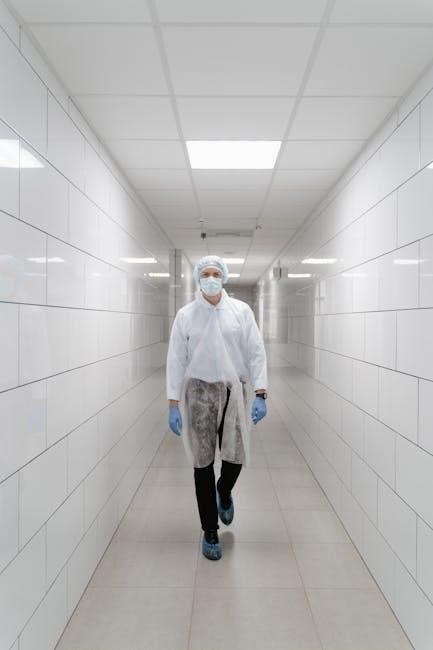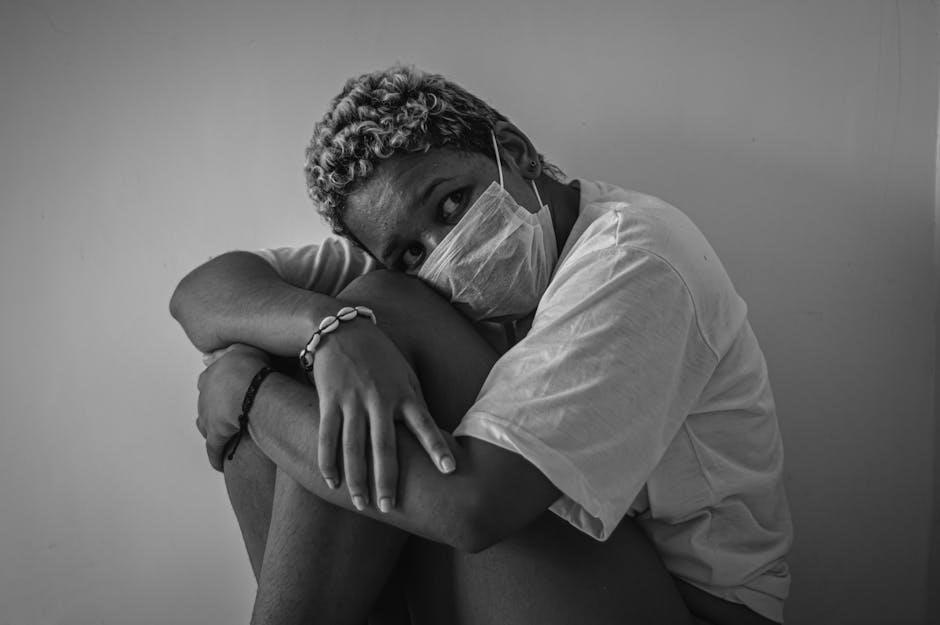Viral infections trigger cellular stress responses, activating pathways like the Unfolded Protein Response (UPR) and stress granule formation, which play roles in viral replication and host defense.
1.1. Background on Virus-Host Interactions
Viral infections initiate dynamic interactions with host cells, triggering cellular stress responses like the Unfolded Protein Response (UPR) and ER stress. These pathways are manipulated by viruses to facilitate replication while evading host defenses, highlighting the complex interplay between viral strategies and host cellular mechanisms.
1.2. Overview of Cellular Stress Responses
Cellular stress responses, including the Unfolded Protein Response (UPR), ER stress, autophagy, and heat shock protein activation, are critical for maintaining homeostasis during viral infections. These pathways manage proteotoxic stress, regulate protein folding, and modulate immune responses, playing dual roles in both host defense and viral exploitation.
1.3. Importance of Studying Stress Pathways in Viral Infections
Understanding stress pathways is crucial for identifying therapeutic targets, as viruses manipulate these pathways for replication and survival. Elucidating their roles can optimize antiviral therapies and enhance immune responses, ultimately improving outcomes in viral infections.

The Role of the Unfolded Protein Response (UPR) in Viral Infections
The UPR is activated during viral infections to manage ER stress caused by viral protein production. It plays a dual role in protecting cells and aiding viral replication.
2.1. Mechanisms of UPR Activation During Virus Replication
During viral replication, the accumulation of viral proteins in the ER triggers ER stress, activating the UPR. Sensors like IRE1, PERK, and ATF6 are activated, leading to the upregulation of chaperones such as BiP and GRP94. This mechanism helps manage proteotoxic stress while enabling selective translation of viral proteins, fostering efficient replication and immune evasion.
2.2. Viral Manipulation of UPR for Replication and Survival
Viruses manipulate the UPR to create a favorable environment for replication and survival. They exploit stress sensors like IRE1 and PERK to suppress or activate specific pathways, ensuring viral protein production while minimizing host cell apoptosis. For example, SARS-CoV-2 and HIV utilize UPR components to optimize replication and evade immune detection, highlighting viral adaptation strategies.
2.3. UPR as a Potential Antiviral Target
The UPR offers a promising target for antiviral therapies, as its manipulation by viruses can be disrupted. Inhibiting key UPR sensors like IRE1 or PERK may block viral replication. Targeting stress pathways could limit viral protein production while sparing essential cellular functions, representing a novel approach in antiviral drug development.

Stress Granules and Their Role in Viral Infections
Stress granules are dynamic structures that sequester mRNAs during cellular stress, playing roles in both defending against viral infections and being manipulated by viruses to aid replication.
3.1. Formation and Function of Stress Granules
Stress granules are dynamic cytoplasmic structures that form in response to cellular stress, sequestering untranslated mRNAs to halt non-essential protein synthesis. They play a critical role in maintaining cellular homeostasis by selectively storing and recycling mRNAs. During viral infections, stress granules can act as defense mechanisms, but viruses often manipulate their dynamics to facilitate replication and evade host responses.
3.2. Viral Modulation of Stress Granule Dynamics
Viruses employ diverse strategies to modulate stress granule dynamics, often disrupting their assembly or exploiting them for replication. Some viruses, like Zika, hijack stress granule proteins to enhance viral translation, while others, such as Enterovirus, suppress granule formation to evade host defenses. These interactions highlight the complex interplay between viral mechanisms and host stress responses.
3.3. Stress Granules as a Defense Mechanism Against Viruses
Stress granules serve as a critical defense mechanism by sequestering viral RNA and proteins, preventing replication. They recruit antiviral factors and modulate innate immune responses. However, some viruses evade this by targeting granule components, highlighting the dynamic interplay between host defense and viral counter strategies in stress granule-mediated immunity.
Endoplasmic Reticulum (ER) Stress and Viral Infections
ER stress is activated during viral replication due to high protein synthesis demands, triggering pathways like the UPR. This response is crucial for viral replication but also presents targets for antiviral therapies.
4.1. ER Stress Activation During Virus Replication
Viral replication induces ER stress by overwhelming the organelle with high protein synthesis demands, leading to misfolded proteins. This triggers the UPR, a protective mechanism that halts translation and increases chaperones. However, prolonged ER stress can disrupt cellular homeostasis, aiding viral replication while potentially harming the host, making it a key target for therapeutic intervention.
4.2. Role of ER Stress in Viral Protein Synthesis and Assembly
ER stress facilitates viral protein synthesis by activating chaperones that assist in folding viral proteins. Viruses exploit this pathway to enhance replication efficiency. However, excessive ER stress can impair viral assembly, highlighting a delicate balance exploited by viruses to optimize their replication while maintaining host cell viability.
4.3. ER Stress Signaling Pathways and Their Impact on Viral Pathogenesis
ER stress signaling pathways, such as the Unfolded Protein Response (UPR), play a critical role in viral pathogenesis by regulating protein folding and cellular homeostasis. These pathways can either promote viral replication or trigger cell death, influencing disease severity. Modulating ER stress signaling offers potential therapeutic strategies to disrupt viral processes and mitigate infection outcomes.

Autophagy and Its Dual Role in Viral Infections
Autophagy serves as a defense mechanism by degrading viral components but can be exploited by viruses to facilitate replication, highlighting its dual role in pathogenesis.
5.1. Autophagy as a Cellular Defense Mechanism
Autophagy acts as a critical cellular defense mechanism by degrading viral particles and components, limiting replication. It also assists in recognizing viral elements, promoting immune responses and maintaining cellular homeostasis during infections.
5.2. Viral Exploitation of Autophagy for Replication
Viruses exploit autophagy to facilitate replication by repurposing autophagic pathways for viral component synthesis and assembly. Certain viral proteins modulate autophagy machinery, enabling evasion of host immune responses and promoting survival within infected cells. This hijacking highlights the dual nature of autophagy in both defense and viral exploitation.
5.3. Modulation of Autophagy Pathways in Antiviral Therapies
Targeting autophagy pathways offers therapeutic potential against viral infections. Inhibiting or enhancing autophagy-related genes can disrupt viral replication. Strategies include modulating PI3K/Akt/mTOR pathways to block viral exploitation. Natural compounds like resveratrol show promise in regulating autophagy, highlighting its role in antiviral therapies. Balancing autophagy modulation is crucial to avoid off-target effects and ensure efficacy in viral clearance.

Heat Shock Proteins (HSPs) and Viral Infections
Heat Shock Proteins (HSPs) play a critical role in cellular stress responses, aiding protein folding and stability. Viruses often exploit HSPs for replication and immune evasion, making them potential targets for antiviral therapies.
6.1. Role of HSPs in Cellular Stress Response
Heat Shock Proteins (HSPs) are essential for maintaining protein homeostasis under stress, aiding in folding and stabilizing proteins. HSP70 and NFAT5 are key players, mitigating proteotoxic stress. Their chaperone functions protect cells during viral infections, though viruses like Vaccinia exploit HSPs for replication, highlighting their dual role in cellular defense and viral manipulation.
6.2. Interaction of Viral Proteins with HSPs
Viral proteins interact with Heat Shock Proteins (HSPs) to stabilize replication machinery and evade host immune responses. For instance, Vaccinia virus co-opts Hsp70 to facilitate viral protein folding and assembly. This interaction enhances viral replication efficiency while modulating host stress responses, highlighting the complex interplay between viral survival strategies and host cellular defense mechanisms.
6.3. HSPs as Potential Targets for Antiviral Strategies
Targeting HSPs offers a promising antiviral approach, as their inhibition can disrupt viral protein folding and replication. Modulating HSP activity may enhance host immune responses while reducing viral survival mechanisms, providing a novel therapeutic strategy against infectious diseases.

Reactive Oxygen Species (ROS) and Viral Pathogenesis
Reactive Oxygen Species (ROS) are generated during viral infections, playing a dual role in promoting replication and immune evasion. Antioxidant therapies may mitigate oxidative stress, offering therapeutic opportunities.
7.1. Generation of ROS During Viral Infections
Reactive Oxygen Species (ROS) are generated during viral infections due to mitochondrial dysfunction, endoplasmic reticulum stress, and viral protein activity. Elevated ROS levels contribute to cellular damage and oxidative stress, while also influencing viral replication efficiency and host immune responses;
7.2. Role of ROS in Viral Replication and Immune Evasion
Reactive Oxygen Species (ROS) facilitate viral replication by modulating host cell environments and compromising antiviral defenses. ROS enhances viral replication by inducing cellular changes that favor virus assembly and release. Simultaneously, ROS suppresses host immune responses, allowing viruses to evade detection and persist within the host. This dual role underscores the significance of ROS in viral pathogenesis and immune evasion strategies.
7.3. Antioxidant Therapies for Managing Viral Infections
Antioxidant therapies, such as N-acetylcysteine (NAC) and vitamin C, show promise in mitigating viral infections by neutralizing ROS. These treatments reduce oxidative stress, enhancing cellular resilience and immune function. Antioxidants also modulate inflammatory responses, potentially limiting tissue damage caused by excessive ROS. Their therapeutic potential lies in complementing antiviral drugs, offering a holistic approach to managing viral infections and associated complications.
DNA Damage Response (DDR) and Viral Infections
DNA damage response (DDR) is activated by viral infections, as viruses often induce replication stress. DDR pathways can either promote viral replication or trigger immune evasion mechanisms.
8.1. Activation of DDR by Viral Infections
Viral infections induce replication stress and DNA damage, triggering the activation of the DNA Damage Response (DDR). DDR pathways detect viral genome integration or replication errors, often leading to cell cycle arrest or apoptosis to restrict viral replication. However, some viruses exploit DDR signaling to facilitate their own replication or evade host immune responses.
8.2. Viral Manipulation of DDR for Replication and Immune Evasion
Viruses manipulate the DNA Damage Response (DDR) to enhance replication and evade immunity. Certain viruses exploit DDR signaling to stabilize their genomes or recruit host repair proteins for replication. Additionally, some viruses inhibit DDR pathways to prevent immune detection, showcasing their ability to adapt and subvert host stress responses for survival and pathogenesis.
8.3. DDR as a Potential Target for Antiviral Interventions
Targeting the DNA Damage Response (DDR) offers a novel antiviral strategy. Inhibiting DDR pathways can disrupt viral replication and restore immune detection. Studies on HIV and herpesvirus show that modulating DDR components limits viral propagation, highlighting its therapeutic potential for developing targeted interventions against diverse viral infections.
Inflammasome Activation and Viral Infections
Inflammasomes detect viral components, triggering cytokine release, such as IL-1β, to combat infections. Viruses often modulate inflammasome activity to evade immune responses and enhance replication.
9.1. Role of Inflammasomes in Antiviral Immunity
Inflammasomes are critical for detecting viral pathogens, activating inflammatory responses. They recognize viral RNA or DNA via pattern recognition receptors, triggering assembly of inflammasome complexes. This leads to caspase-1 activation, cleavage of pro-inflammatory cytokines IL-1β and IL-18, and pyroptosis, orchestrating antiviral immunity and restricting viral replication through coordinated inflammatory signaling.
9.2. Viral Strategies to Modulate Inflammasome Activity
Viruses employ diverse strategies to modulate inflammasome activity, including encoding proteins that inhibit NLRP3 inflammasome activation or producing decoy receptors to neutralize inflammatory signals. Some viruses disrupt inflammasome assembly or degrade key components, while others exploit host pathways to suppress cytokine production, thereby evading immune detection and promoting replication. These mechanisms highlight viral immune evasion tactics.
9.3. Therapeutic Targeting of Inflammasomes in Viral Diseases
Therapeutic strategies targeting inflammasomes focus on modulating their activity to balance inflammation and immune defense. Small molecule inhibitors, gene therapy, and immunomodulatory drugs are being explored to regulate inflammasome activation. These approaches aim to suppress excessive inflammation while maintaining antiviral immunity, offering potential treatments for viral diseases by targeting specific inflammasome components like NLRP3.

Virus-Specific Stress Pathways
Different viruses exhibit unique interactions with host stress pathways, such as SARS-CoV-2 manipulating UPR, HIV targeting DDR, and hepatitis viruses affecting stress granules and ROS pathways.
10.1. SARS-CoV-2 and Stress Pathways
SARS-CoV-2 triggers endoplasmic reticulum stress and activates the unfolded protein response (UPR) to facilitate viral replication. The virus also induces reactive oxygen species (ROS) generation and manipulates DNA damage response (DDR) pathways to evade immune detection, promoting pathogenesis and replication efficiency in host cells.
10.2. HIV and Stress Pathways
HIV infection induces cellular stress responses, including the formation of stress granules and activation of the unfolded protein response (UPR). The virus manipulates ER stress pathways to enhance replication and survival. Additionally, HIV triggers reactive oxygen species (ROS) generation, disrupting host redox balance and contributing to immune evasion and disease progression.
10.3. Hepatitis Viruses and Stress Pathways
Hepatitis viruses activate endoplasmic reticulum (ER) stress and the unfolded protein response (UPR) during replication. Viral proteins interact with UPR components, such as GRP78 and CHOP, to modulate stress pathways, facilitating replication and survival. Chronic ER stress contributes to liver damage and fibrosis, highlighting the role of stress pathways in hepatitis virus pathogenesis and disease progression.
Cross-Talk Between Stress Pathways and Innate Immunity
Stress pathways interact with innate immunity, enhancing antiviral responses through mechanisms like stress granules, but viruses exploit these pathways to evade detection and promote replication.
11.1. Synergy Between Stress Pathways and Innate Immune Responses
Stress pathways, such as the UPR and autophagy, synergize with innate immunity to detect viral components and activate antiviral defenses. Stress granules sequester viral RNA, enhancing immune recognition, while UPR signaling modulates cytokine production, creating a coordinated response to limit infection spread and promote viral clearance.
11.2. Viral Strategies to Disrupt Stress-Immune Crosstalk
Viruses employ strategies to disrupt stress-immune crosstalk, such as modulating the UPR to suppress cytokine production or interfering with stress granule dynamics to evade immune detection. These tactics allow viruses to impair host defense mechanisms, facilitating replication and immune evasion while maintaining cellular homeostasis for their benefit.
11.3. Enhancing Innate Immunity Through Stress Pathway Modulation
Targeting stress pathways offers potential to enhance innate immunity by promoting antiviral granule formation and interfering with viral replication processes. Modulation of UPR and stress granules can activate immune sensors, boosting cytokine production and restricting viral spread, providing a novel approach to strengthen host defense mechanisms against infections.
Therapeutic Implications of Targeting Stress Pathways in Viral Infections
Modulating stress pathways offers therapeutic potential to disrupt viral replication and enhance immune responses, providing novel strategies for antiviral therapies and improving disease outcomes.
12.1. Small Molecule Inhibitors of Stress Pathways
Small molecule inhibitors targeting stress pathways, such as ER stress or UPR, show promise in disrupting viral replication by blocking key signaling nodes. These inhibitors can prevent viruses from exploiting stress responses for replication, offering a targeted approach to antiviral therapies and potentially enhancing treatment efficacy against various viral infections.
12.2. Gene Therapy Approaches to Modulate Stress Responses
Gene therapy approaches aim to modulate stress pathways by targeting specific genes involved in ER stress, UPR, or other cellular responses. By enhancing or inhibiting these pathways, gene therapies can inhibit viral replication and promote cellular resilience, offering a novel strategy to combat viral infections and mitigate disease progression.
